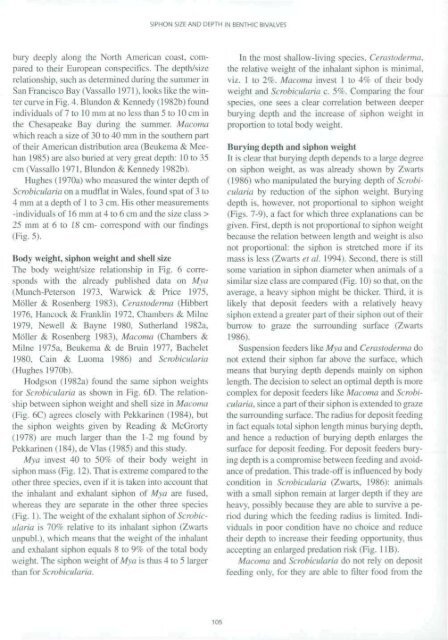waders and their estuarine food supplies - Vlaams Instituut voor de ...
waders and their estuarine food supplies - Vlaams Instituut voor de ...
waders and their estuarine food supplies - Vlaams Instituut voor de ...
You also want an ePaper? Increase the reach of your titles
YUMPU automatically turns print PDFs into web optimized ePapers that Google loves.
ury <strong>de</strong>eply along the North American coast, compared<br />
to <strong>their</strong> European conspecifics. The <strong>de</strong>pth/size<br />
relationship, such as <strong>de</strong>termined dining the summer in<br />
San Francisco Bav iVassallo 1971). looks like the winter<br />
curve in Fig. 4. Blundon & Kennedy (1982b) found<br />
individuals of 7 to 10 mm at no less than 5 to 10cm in<br />
the Chesapeake Bay during the summer. Macoma<br />
which reach a size of 30 to 40 mm in the southern part<br />
of <strong>their</strong> American distribution area (Beukema & Meehan<br />
1985) are also buried at very great <strong>de</strong>pth: 10 to 35<br />
cm (Vassallo 1971. Blundon & Kennedy 1982b).<br />
Hughes (1970a) who measured the winter <strong>de</strong>pth of<br />
Scrobicularia on a mudllat in Wales, found spat of 3 to<br />
4 mm at a <strong>de</strong>pth of 1 to 3 cm. His other measurements<br />
-individuals of 16 mm at 4 to 6 cm <strong>and</strong> the si/e class ><br />
25 mm at 6 lo 18 cm- correspond with our findings<br />
(Fig. 51.<br />
Body weight, siphon weight <strong>and</strong> shell size<br />
The body weight/size relationship in Fig. 6 corresponds<br />
with the already published data on Mya<br />
(Munch-Peterson 1973. Warwick & Price 1975.<br />
Miiller & Rosenberg 1983). Cerasto<strong>de</strong>rma (Hibbert<br />
1976, Hancock & Franklin 1972. Chainbeis & Milne<br />
1979. Newell & Bayne 1980, Sutherl<strong>and</strong> 1982a,<br />
Moller & Rosenberg 1983). Macoma (Chambers &<br />
Milne 1975a. Beukema & <strong>de</strong> Bruin 1977, Bachelet<br />
1980. Cain & Luoma 1986) <strong>and</strong> Scrobicularia<br />
(Hughes 1970b).<br />
Hodgson 11982a) found the same siphon weights<br />
for Scrobicularia as shown in Fig. 6D. The relationship<br />
between siphon weight <strong>and</strong> shell size in Macoma<br />
(Fig. 6C) agrees closely with Pekkarinen (1984). but<br />
the siphon weights given by Reading & McGrorty<br />
(1978) are much larger than the 1-2 mg found by<br />
Pekkarinen (184). <strong>de</strong> Vlas (1985) <strong>and</strong> ihis study.<br />
Mya invest 40 to 50% of <strong>their</strong> body weight in<br />
siphon mass (Fig. 12). That is extreme compared to the<br />
other three species, even if it is taken into account that<br />
the inhalant <strong>and</strong> exhalant siphon of Mya are fused,<br />
whereas Ihey are separate in the other three species<br />
(Fig. 1). The weight of the exhalant siphon oi Scrobicularia<br />
is 70*36 relative to its inhalant siphon (Zwarts<br />
unpubl.). which means lhat the weight of the inhalant<br />
<strong>and</strong> exhalant siphon equals 8 to 9% of the total body<br />
weight. The siphon weight of Mya is thus 4 to 5 larger<br />
than for Scrobicularia.<br />
SIPHON SIZE AND DEPTH IN BENTHIC BIVALVES<br />
105<br />
In the most shallow-living species. Cerasto<strong>de</strong>rma.<br />
the relative weight of the inhalant siphon is minimal.<br />
viz. 1 to 2%. Macoma invest I to 4'/< of then body<br />
weight <strong>and</strong> Scrobicularia c. 5%. Comparing the four<br />
species, one sees a clear correlation between <strong>de</strong>eper<br />
burying <strong>de</strong>pth <strong>and</strong> the increase of siphon weight in<br />
proportion to total body weighl.<br />
Burying <strong>de</strong>pth <strong>and</strong> siphon weight<br />
It is clear that burying <strong>de</strong>pth <strong>de</strong>pends to a large <strong>de</strong>gree<br />
on siphon weight, as was already shown by Zwarts<br />
( 1986) who manipulated the burying <strong>de</strong>pth of Scrobicularia<br />
by reduction of the siphon weight. Burying<br />
<strong>de</strong>pth is, however, not proportional to siphon weight<br />
(Figs. 7-9), a fact for which three explanations can be<br />
given. First, <strong>de</strong>pth is not proportional to siphon weighl<br />
because the relation between length <strong>and</strong> weight is also<br />
not proportional: the siphon is stretched more if its<br />
mass is less i/warts ci al. 1994). Second, there is still<br />
some variation in siphon diameter when animals of a<br />
similar size class are compared (Fig. 10) so that, on the<br />
average, a heavy siphon might be thicker. Third, il is<br />
likely that <strong>de</strong>posit fee<strong>de</strong>rs with a relatively heavy<br />
siphon extend agieatei part of Iheii siphon out of <strong>their</strong><br />
burrow to graze the surrounding surface (Zwarts<br />
1986).<br />
Suspension fee<strong>de</strong>rs like Mya <strong>and</strong> Cerasto<strong>de</strong>rma do<br />
not extend Iheir siphon far above the surface, which<br />
means that burying <strong>de</strong>pth <strong>de</strong>pends mainly on siphon<br />
length. The <strong>de</strong>cision to select an optimal <strong>de</strong>pth is more<br />
complex for <strong>de</strong>posit fee<strong>de</strong>rs like Macoma <strong>and</strong> Scrobicularia.<br />
since a part of <strong>their</strong> siphon is exten<strong>de</strong>d to graze<br />
the surrounding surface. The radius lor <strong>de</strong>posit feeding<br />
in fact equals total siphon length minus burying <strong>de</strong>pth,<br />
<strong>and</strong> hence a reduction of burying <strong>de</strong>pth enlarges the<br />
sin face for <strong>de</strong>posit feeding. For <strong>de</strong>posit fee<strong>de</strong>rs burying<br />
<strong>de</strong>pth is a compromise between feeding <strong>and</strong> avoidance<br />
of predation. This tra<strong>de</strong>-off is influenced by body<br />
condition in Scrobicularia (Zwarts. 1986): animals<br />
with a small siphon remain at larger <strong>de</strong>pth if they archeavy,<br />
possibly because they are able to survive a period<br />
during which the feeding radius is limited. Individuals<br />
in poor condition have no choice <strong>and</strong> reduce<br />
<strong>their</strong> <strong>de</strong>pth to increase <strong>their</strong> feeding opportunity, thus<br />
accepting an enlarged predation risk (Fig. 1 IB).<br />
Macoma <strong>and</strong> Scrobicularia do not rely on <strong>de</strong>posit<br />
feeding only, for they are able to filter <strong>food</strong> from the

















